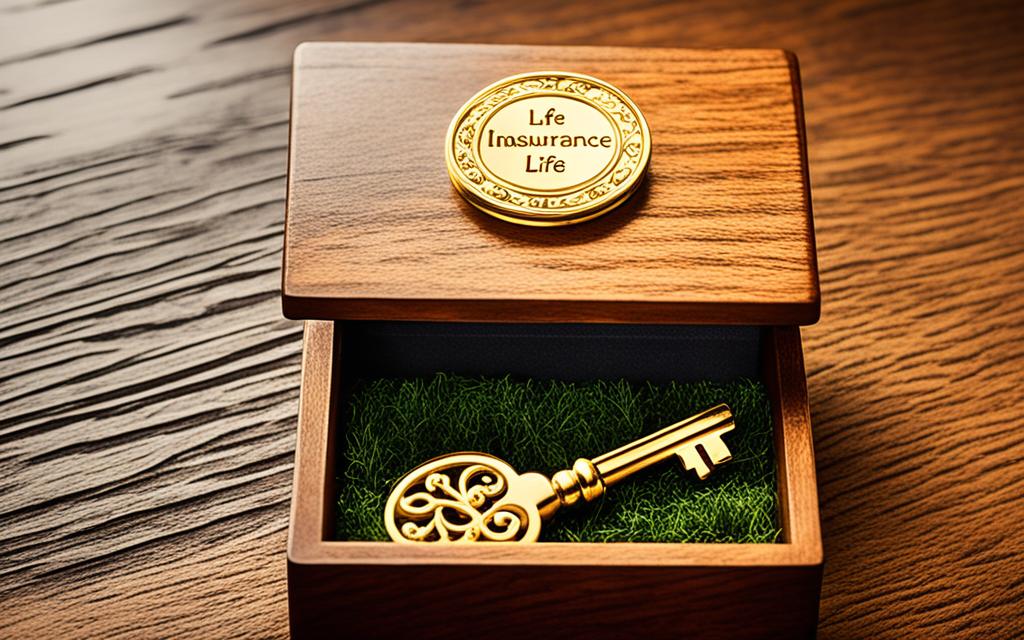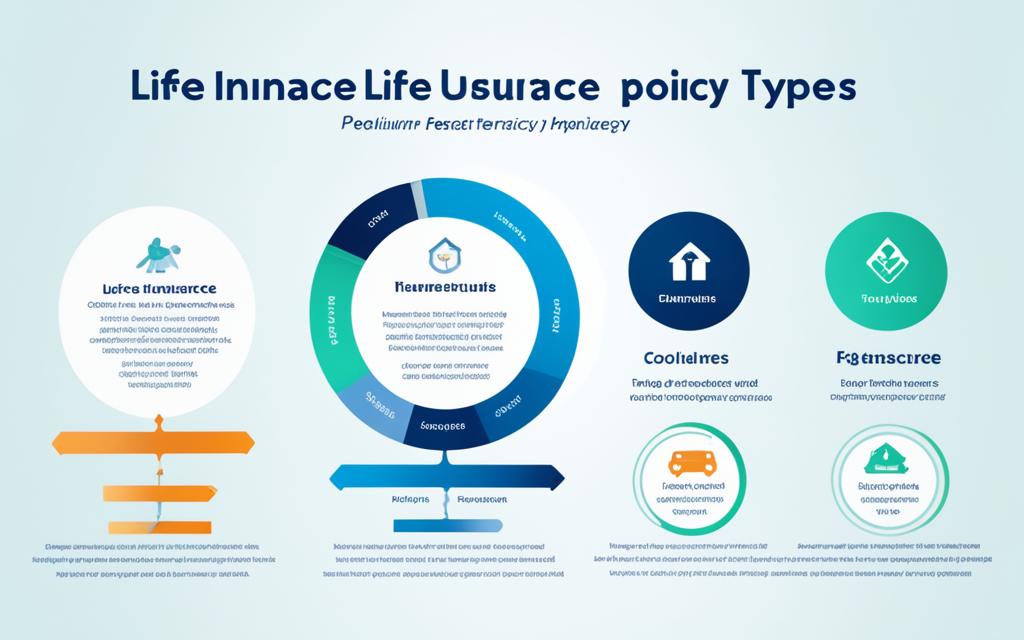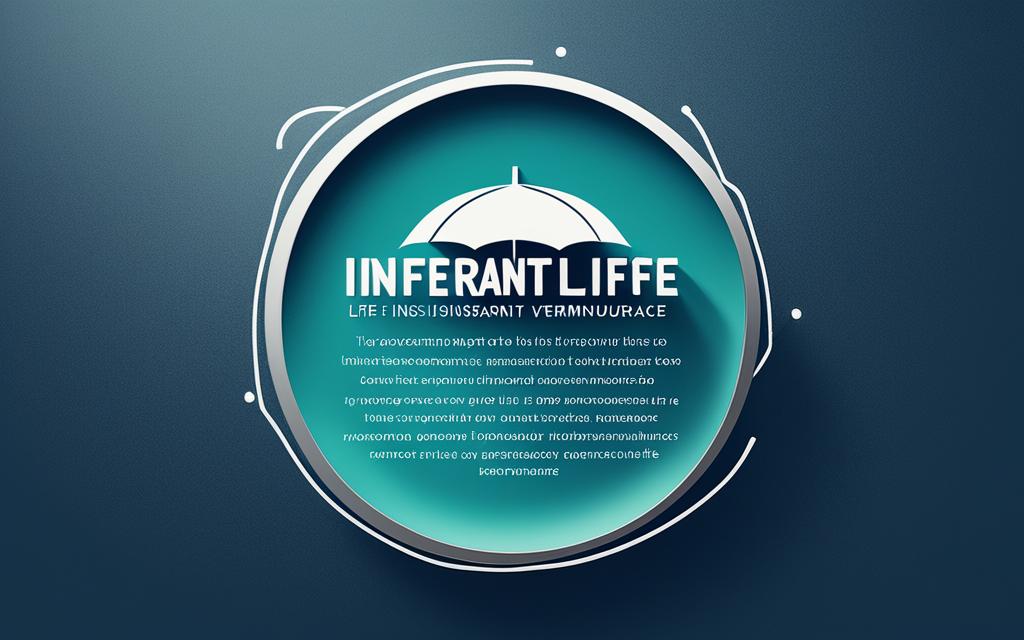Life insurance is a contract between you and an insurance company. They promise to give money to your chosen people when you pass away. This is in return for the money you paid them over time.1 The top life insurance companies not only pay when needed but also let you add extra protection, are financially sound, listen to customers, and make it easy to join. Learning about life insurance’s different types, what affects the cost, and how to get it, is key. It helps ensure your family’s future is safe. This guide aims to offer tips on getting the best life insurance for your needs and lifestyle.
Key Takeaways
- Life insurance is a contract that pays out when you die, helping your loved ones financially.
- The best life insurance companies have many policy options, good financial ranks, and simple sign-up steps.
- It’s crucial to understand life insurance basics, like what types are out there, what impacts cost, and how to buy. This info is vital for a solid financial plan.
- This article plans to fully inform you on upgrading your finances with superb life insurance choices.
- Choosing the correct life insurance can protect your family’s tomorrow and ensure peace about your finances.
Understanding Life Insurance
Life insurance is a way to financially protect your loved ones when you die.2 It ensures they have money for living costs, like a spouse’s or kids’ needs. It also helps with final costs and debts, offering peace of mind.2 Having life insurance means you leave a legacy for your heirs, even if you have no other wealth to pass on.2
What Is Life Insurance?
It’s a deal with an insurance company to pay your chosen beneficiaries when you pass. You pay premiums, they get the benefit.2 This money can handle taxes, letting your family keep other assets. You can also give to charity in your name this way.2
Types of Life Insurance
Life insurance comes in two main forms: term and permanent.2 Term life pays if you die within a set time. Permanent life lasts forever and can grow in value.2
Term Life Insurance
Term life protects you for a set number of years and pays if you pass during this time.1 It’s usually cheaper for short-term needs.
Permanent Life Insurance
Permanent life lasts your whole life and builds cash value.2 It includes different types like whole life that stay the same in cost, and universal life that lets you adjust as needed. There’s also variable life which means the value can change based on investments, with more risk.2
Knowing the options helps you pick what’s best for your family’s future and your financial plans.
Key Factors Affecting Life Insurance Premiums
Life insurance costs depend on age, health, gender, and lifestyle. Family health history also matters. Knowing these factors helps plan for life insurance costs.
Age and Health
Youth and good health often mean lower life insurance prices. Every year older adds 8% to 10% to the cost.3 Problems like high cholesterol might make insurance more expensive.4 Heart issues, high cholesterol, diabetes, and sleep apnea can all raise costs.
Gender and Lifestyle
Women usually pay less since they live longer on average.3 Their occupations and hobbies are also checked. Risky jobs or hobbies and tobacco use can increase rates.3 If you smoke, your premiums might be higher.
Family Medical History
Family health history is vital. It can raise prices if it includes heart disease or cancer.4 A history of certain diseases means you might pay more.3 Serious family health issues can spike premium costs.
Life Insurance Basics
Life insurance provides a death benefit to named beneficiaries when someone insured dies.2 This benefit can help pay for things like funeral costs, debts, and support for the family left behind.2 To keep the policy active, the policyholder must pay premiums, which can be monthly, quarterly, or yearly.2 The amount the insurance will pay is called the coverage amount or face value.2 Knowing these key points is crucial for choosing the right policy. It’s how you make sure your family is financially secure.

Life insurance is key for a good financial plan.2 It takes care of income for loved ones if the policyholder dies.2 It can also handle funeral and medical costs, debts, and more.2 Having heirs as beneficiaries can help with taxes and keep estate assets intact.2 Naming a charity can mean a big donation. Some policies also build a cash value over time.2
Term life insurance only pays if the insured dies within the set term, usually from one to 30 years.2 Whole life insurance pays whenever the policyholder dies.2 There are three main types of whole life insurance: traditional whole life, universal life, and variable universal life.2 Traditional whole life insurance keeps both the death benefit and premium the same over the policy’s life.2 Universal life policies are more flexible, allowing changes to premiums based on the cash value.2 Variable life policies include a savings part that can go into investments.2 Universal variable life merges features from both, offering investment options with flexible benefits.2
Shopping for the Right Life Insurance Policy
To find the best life insurance, start by figuring out what you need. Think about how much your family relies on you for money. This includes your salary, any debts you have, and what your loved ones would need if you were gone.5 Knowing this will let you pick the right amount of coverage. Then, you fill out an application. It asks for personal info, health history, and facts about what you do and how you live.
Determining Your Coverage Needs
Calculate a fund that covers big costs your family would face without you. This includes your home loan, kids’ college, debts, and a replacement for your income.1 This figure guides you to the suitable amount of coverage to secure their financial future.
Preparing Your Application
Getting life insurance involves giving details about your and your family’s health. You may also need to take a health check and talk about your hobbies and how you get around.1 Collecting this info early makes the application go smoother.
Comparing Policy Quotes
It’s important to look at quotes from different insurance companies. This lets you choose a policy that fits your budget and meets your needs.1 Be thorough in your evaluation so you can get a policy that truly protects those you care about.
Life Insurance Policy Types and Features
Life insurance comes in several types, each with its own benefits. By understanding these options, you can find the coverage that matches your financial plans.
Whole Life Insurance
Whole life insurance offers coverage for life, guaranteed to pay a death benefit.6 This is different from term life insurance, which covers you for a set time. It also builds cash value over time, which you can use or borrow against.2
Universal Life Insurance
Universal life insurance is more flexible than whole life.2 It has a cash value feature like whole life. But it lets you change your premium and benefit as life changes, which can be really handy.
Variable Life Insurance
Variable life insurance lets you invest the cash value part in stocks and funds.2 This could bring more return but means more risk. It’s for those comfortable with risk looking for growth opportunities.

Learn about whole, universal, and variable life insurance to see what matches your needs. Think about your financial goals and how much risk you’re willing to take. This way, you can pick the life insurance that helps protect your future and grow your wealth.
Top-Rated Life Insurance Companies
When you’re looking for the best life insurance, it’s key to check out the financial strength and what customers think. Also, look at the kinds of plans they offer. In the United States, Nationwide, Protective, MassMutual, and others stand out for their quality.7
These top companies have top marks from A.M. Best for their financial muscle.7 This means they’re reliable when it comes to paying out claims. They have lots of different plans and ways you can customize your coverage. This makes life insurance shopping easier and more tailored to you.7
MassMutual is praised for its solid finances, how you can buy a policy online, and its low complaints.7 Guardian is known for helping people with HIV get covered. They also offer some unique plans.7 MassMutual’s 2024 payout of over $2 billion to their policyholders is the highest it’s ever been.7
Important details like what plans they have, their financial scores, and how easy it is to buy insurance online are shared for these top companies.7
| Insurer | J.D. Power Score (2023) | AM Best Financial Strength Rating | Notable Features |
|---|---|---|---|
| Nationwide | 840/1,0008 | A (Excellent)8 | Excels in customer satisfaction8 |
| State Farm | 843/1,0008 | A++ (Superior)8 | Known for offering term life insurance8 |
| Guardian | N/A | A++ (Superior)8 | Offers life insurance coverage without a medical exam8 |
| MassMutual | N/A | A++ (Superior)8 | Recognized as the best for whole life insurance8 |
| Mutual of Omaha | N/A | A+ (Superior)8 | Stands out for digital accessibility8 |
| Northwestern Mutual | N/A | A++ (Superior)8 | Highly regarded for universal life insurance8 |
| Prudential | N/A | A+ (Superior)8 | Specializes in policy personalization8 |
The top life insurance companies for 2024 got five stars across the board.7 They have all kinds of plans, from term life to whole life. NerdWallet’s reviews focus on what customers think, financial health, and complaint data. They look at how easy it is to talk to the company, how clear their website is, and what you can learn about their plans online.7
The best companies usually have an A- or better financial rating.7 They also get fewer than usual complaints. You can buy their insurance straight from their websites. The National Association of Insurance Commissioners checks on all this.7
Reviews consider what plans they have, their money situation, complaints from customers, and how easy it is to buy online.7 By looking at these, you can find the best life insurance for you and your budget.
Term vs. Permanent Life Insurance
Term and permanent life insurance are different in how long they last. Term life covers you for a set number of years, like 10, 20, or 30. It pays out if you die during that time.9 Permanent life insurance lasts your whole life. It also has a cash value component that grows over time.9 When choosing between them, think about your age, financial goals, and coverage needs.
When to Choose Term Life Insurance
Term life insurance is usually cheaper and for short-term needs. It’s good for people who only need insurance until their kids are grown or their mortgage is paid. Plus, it costs less than permanent life insurance, which helps if you’re watching your budget.10
When to Choose Permanent Life Insurance
Permanent life insurance is for long-term goals and passing wealth to loved ones. It lasts your whole life. You can use its cash value for big expenses, like college, or in emergencies.10 It also has tax benefits and your premium stays stable. This might make it a better value in the long run. But, it’s more expensive upfront than term life insurance because it offers more features.9
Deciding on the right coverage and policy type means thinking about your needs. It’s wise to speak with a financial advisor. They can help you choose between term or permanent life insurance, based on what fits your life best.910

Accelerated Death Benefits and Viatical Settlements
Most life insurance has ways to get money early. This is for people with serious or long-term illnesses.11 More than 150 companies let their customers get these early benefits.11 Right now, about 3 million Americans have this in their plans.11
People can get part of their policy’s money early if they are very sick. The sickness must be something they will likely not recover from.12 Different companies have different rules for this. They might need a doctor to say you have less than 2 years to live.12 The amount you can get early varies from 25% to all the money. You can get it once or over time.11
Viatical settlements are when you sell your policy for cash. Someone buys it from you for less money than the policy is worth.12 They usually pay somewhere between 55% and 80% of the policy’s money.11
These options are helpful when you need money because of illness. But, they change some things. Things like how much money your family gets when you die could be less.12 Getting early death benefits might make it hard to get government help later. How you’re taxed on this money can also change.12
| Accelerated Death Benefits | Viatical Settlements |
|---|---|
| Allow accessing a portion of the policy’s death benefit while the policyholder is alive12 | Involve selling the life insurance policy to a third-party company for immediate cash12 |
| Typically require proof of terminal illness with a life expectancy of 24 months or less12 | Policyholders typically receive 55 to 80 percent of the death benefit11 |
| May be available for critical, chronic, or catastrophic illnesses, long-term care, or nursing home confinement12 | Can provide immediate cash, but the policyholder relinquishes ownership of the policy12 |
| Often included in terminal illness coverage at no extra cost, but may come with a higher premium for other conditions12 | Differ from accelerated death benefits, which allow accessing money while the policyholder is alive without selling the coverage12 |
| Typically allow withdrawing 25% to 95% of the death benefit, subject to the policy’s face value and state regulations12 | Insurers cannot cancel or alter coverage if a policyholder becomes terminally ill12 |
Accelerated death benefits and viatical settlements are valuable for those with serious illnesses. But, you need to know how they work.12
Choosing the Right Life Insurance Policy
Choosing the right life insurance policy is vital. You must understand your coverage needs and know what each policy offers.13 First, think about your dependents’ financial needs. This includes things like providing income, paying off debts, and future expenses like education. This will help figure out the amount of life insurance your family may need.13
Evaluating Your Needs
When thinking about your insurance needs, look at how much of the family income you provide. Also, think about changes in what your family might need financially.13 As you get older, the need for life insurance usually goes up. By understanding your situation, you can pick the life insurance that gives your family the best safety and security for the future.
Understanding Policy Provisions
Next, look at what the policy offers. This includes the death benefit, how much you pay in premiums, and what cash value it might have. Also, check out any special features you might want to add to your policy.13 Knowing how the cash value works is key. Some policies grow in value over time, and others might only grow a lot towards the end.13 It’s also very important to be honest on your application. Insurers check that the info you give is correct to avoid problems with your coverage later on.13
By understanding what you truly need and knowing what the policy offers, you can make a smart choice. This choice will provide your family with protection and secure your financial future.141513

Conclusion
Life insurance is crucial for your financial plan, providing security for your family if something happens to you.1 Learning about it means you can get excellent coverage that fits your life.1 You might pick term life for temporary needs or whole life for a permanent solution. Choosing the right one safeguards your family’s money well.16
Getting life insurance today gives you peace for tomorrow.16 Top companies like Nationwide, Protective, and MassMutual have you covered. They offer policies up to $5 million with many options to fit your needs.1 With the right policy, you can enjoy life, knowing your family is financially secure.
FAQ
What is life insurance?
What are the main types of life insurance?
What factors affect life insurance premiums?
What is a death benefit?
How do I shop for the right life insurance policy?
What are the different types of life insurance policies?
Which are the top-rated life insurance companies?
When should I choose term life insurance vs. permanent life insurance?
What are accelerated death benefits and viatical settlements?
How do I choose the right life insurance policy?
Source Links
- https://www.investopedia.com/terms/l/lifeinsurance.asp
- https://www.iii.org/article/life-insurance-basics
- https://www.investopedia.com/articles/investing/102914/7-factors-affect-your-life-insurance-quote.asp
- https://www.forbes.com/advisor/life-insurance/factors-affecting-rates/
- https://www.usnews.com/insurance/life-insurance/how-to-buy-life-insurance
- https://www.forbes.com/advisor/life-insurance/types/
- https://www.nerdwallet.com/article/insurance/best-life-insurance-companies
- https://www.bankrate.com/insurance/life-insurance/best-life-insurance-companies/
- https://www.securian.com/insights-tools/articles/term-life-vs-permanent-life.html
- https://www.newyorklife.com/articles/term-or-permanent-life-insurance
- https://www.aldoi.gov/consumers/BenefitsQandA.aspx
- https://www.nerdwallet.com/article/insurance/accelerated-death-benefit
- https://content.naic.org/article/consumer-insight-what-type-life-insurance-right-you
- https://www.investopedia.com/how-to-choose-life-insurance-7483886
- https://www.iii.org/article/how-choose-right-type-life-insurance
- https://www.manning-napier.com/insights/an-introduction-to-life-insurance
